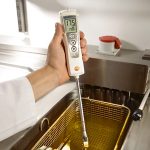In the grand scheme of things, an HVAC system is just one out of many components that make a building. Yet, its contribution to the structure as a whole is huge because it allows you to control indoor climates.
But climate doesn’t come down to either heating, cooling, ventilation, humidity or air quality. Rather, climate is an amalgamation of all these characteristics. That’s one of the reasons why HVAC technicians and building managers use multi-function instruments to measure various factors.
The ideal indoor temperature is between 20 and 25 degrees Celsius.
The importance of indoor climates
There are two reasons why professionals assess indoor air quality. First, doing so shows them whether HVAC systems are operating optimally. Second, it enables business leaders to determine how humidity, temperature and other factors impact employee productivity.
According to Worldwatch Institute Europe, we spend between 80 and 90 per cent of our time indoors. This means the structures in which we work and live have a significant impact on our health and well-being.
Research has repeatedly proven this assertion. Consider the following data:
- A study published in Elsevier found that ineffective contaminant removal processes can decrease productivity between 0.5 and 2 per cent.
- The University of Reading’s Dr Derek Clements-Croome noted that ventilation rates below 10 litres per second (l/s) per person increases health problems.
- The American Society of Heating, Refrigerating and Air-Conditioning Engineers (ASHRAE) recommends that building managers set relative humidity between 40 and 55 per cent.
- ASHRAE also discovered that the ideal indoor temperature is between 20 and 25 degrees Celsius.
Taking these four factors into consideration is just the beginning. HVAC technicians need to figure out how ventilation impacts temperature, humidity, indoor air quality and so forth. The chief objective is to determine how each factor affects another.
Multiple readings, one device
Instead of using separate devices to calculate office humidity, temperature, ventilation and air quality, it’s much more feasible for personnel to use one device capable of measuring multiple factors.
 How can you bring the freshness of the outdoors into your office?
How can you bring the freshness of the outdoors into your office?For example, the testo 480 climate measurement tool comes with a range of optional probes that enable you to measure, analyse and log several parameters through one device. It’s the only instrument you’ll need to register temperatures, humidity levels, differential and absolute pressure, carbon dioxide, heat radiation, turbulence and other factors.
To make it easy for you to view your readings, you can take advantage of the testo 480’s ‘Easy Climate’ software. This allows you to easily transfer measurements to a computer, where you can assess the data at your own discretion.
As multiple elements make up an ideal working environment, it’s imperative professionals have the tools necessary to analyse them.









 Reduce cooking oil costs while ensuring quality
Reduce cooking oil costs while ensuring quality Expert knowledge on CO2 monitoring
Expert knowledge on CO2 monitoring Refrigeration knowledge - in 3 modules
Refrigeration knowledge - in 3 modules



